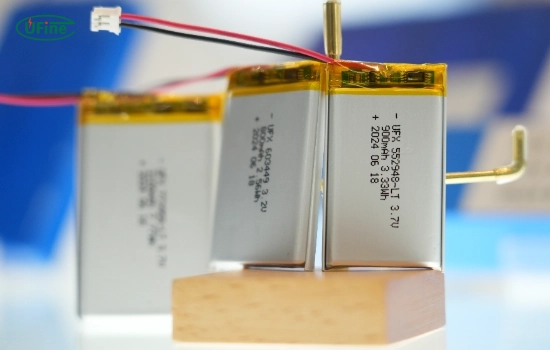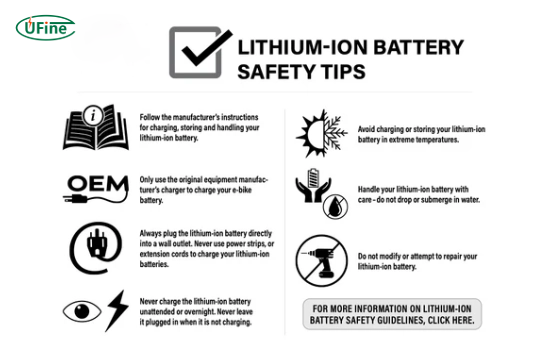Safe lithium-ion batteries have become integral to our daily lives, powering everything from smartphones to electric vehicles. However, with their widespread use comes the responsibility of understanding how to handle them safely. This guide will explore the essential aspects of lithium-ion battery safety, including its structure, typical hazards, best practices for usage, manufacturing standards, and disposal methods.
Part 1. What are lithium-ion batteries?
Lithium-ion batteries are rechargeable energy storage devices that have gained popularity due to their high energy density and lightweight characteristics. They consist of an anode, cathode, electrolyte, and separator. Here’s a brief overview of their components:
- Anode: Typically made of graphite, it stores lithium ions during charging.
- Cathode: Usually composed of lithium metal oxides, it releases lithium ions during discharge.
- Electrolyte: A lithium salt dissolved in an organic solvent that allows ions to move between the anode and cathode.
- Separator: A porous membrane that prevents direct contact between the anode and cathode while allowing ion flow.
People favor lithium-ion batteries because they can hold a charge for extended periods and have relatively low self-discharge rates compared to other battery types.
Part 2. Why are lithium-ion batteries popular?
Several factors contribute to the popularity of lithium-ion batteries:
- High Energy Density: They can store more energy in a smaller volume than traditional batteries.
- Long Cycle Life: Lithium-ion batteries can endure hundreds of charge/discharge cycles, making them cost-effective in the long run.
- Low Maintenance: Unlike some other battery types, lithium-ion batteries do not require regular maintenance, such as topping off electrolyte levels.
- Rapid Charging: These batteries can be charged quickly, making them ideal for modern devices that need minimal downtime.
Part 3. Common hazards associated with lithium-ion batteries
Despite their advantages, lithium-ion batteries can pose safety risks if mishandled. Some common hazards include:
- Thermal runaway occurs when a battery overheats, leading to a self-sustaining reaction that can cause fires or explosions.
- Physical Damage: Punctures or impacts can compromise the battery’s integrity, leading to leaks or short circuits.
- Overcharging: Charging a battery beyond capacity can generate excessive heat, increasing the risk of thermal runaway.
- Improper Disposal: Disposing lithium-ion batteries in regular trash can lead to environmental hazards and fire risks.
Part 4. Best practices for safe lithium-ion battery usage
To ensure the safe use of lithium-ion batteries, follow these best practices:
- Use Certified Chargers: Always use chargers specifically designed for your battery type and certified by recognized testing laboratories.
- Avoid Extreme Temperatures: Store and operate batteries within the recommended temperature range (typically between 5°C and 20°C) to prevent overheating or freezing.
- Monitor Battery Health: Regularly check for signs of damage, such as swelling, leaking, or corrosion. If any issues are detected, stop using the battery immediately.
- Charge Responsibly: Do not leave batteries unattended; remove them from the charger once fully charged.
- Store Properly: Keep batteries in a cool, dry place away from flammable materials and direct sunlight.
Part 5. Manufacturing standards for safe lithium-ion batteries
Manufacturing standards play a crucial role in ensuring the safety and reliability of lithium-ion batteries. Key standards include:
- IEC 62133: This international standard outlines safety requirements for portable sealed secondary cells, including lithium-ion batteries. It focuses on performance, safety, and environmental considerations.
- UL 2054: A standard developed by Underwriters Laboratories that evaluates the safety of lithium-ion batteries used in consumer products, ensuring they meet rigorous safety criteria.
- ISO 9001: This quality management standard ensures manufacturers implement effective processes to maintain product quality and safety throughout the production cycle.
Adhering to these standards helps mitigate risks and ensures manufacturers meet high safety specifications for lithium-ion batteries.
Part 6. Identifying damaged lithium-ion batteries
Recognizing the signs of a damaged lithium-ion battery is crucial for safety. Some indicators include:
- Swelling: Handle a bloated battery carefully, as it can indicate internal damage.
- Leaking: Any signs of fluid leakage require immediate attention, as the contents can be hazardous.
- Heat: If a battery feels excessively warm during use or charging, it may malfunction.
- Physical Deformities: Cracks or dents on the battery casing can compromise safety.
Part 7. Emergency procedures for lithium-ion battery incidents
In the event of a battery failure or fire, follow these emergency procedures:
- Evacuate the Area: Ensure everyone is safe from the battery.
- Use Protective Gear: If you must handle a damaged battery, wear gloves and safety goggles to protect yourself.
- Contain the Fire: If a fire occurs, use a Class D fire extinguisher specifically designed for metal fires. Do not use water.
- Contact Authorities: Call local emergency services for assistance if the situation escalates.
Part 8. Proper disposal methods
Disposing of lithium-ion batteries responsibly is essential to prevent environmental harm. Here are some recommended disposal methods:
- Recycling Programs: Many communities offer recycling programs for batteries. Check local resources for drop-off locations.
- Retail Take-Back Programs: Some retailers provide battery recycling services. Look for designated collection bins.
- Hazardous Waste Facilities: If no other options are available, contact dangerous local waste facilities for guidance on safe disposal.
Part 9. FAQs
-
What should I do if my lithium-ion battery is swollen?
If your lithium-ion battery is swollen, stop using it immediately. Carefully remove it from the device, if possible, and place it in a fire-resistant container. Contact a recycling facility for proper disposal. -
Can I charge my lithium-ion battery overnight?
While many modern devices have built-in protections against overcharging, it is still advisable to avoid leaving batteries unattended for extended periods. Unplug the charger after you have fully charged the battery. -
How can I extend the lifespan of my lithium-ion battery?
To extend the lifespan of your lithium-ion battery, avoid extreme temperatures, do not let it discharge entirely regularly, and use it within the manufacturer’s recommended specifications. -
Are lithium-ion batteries safe for all devices?
When used correctly, lithium-ion batteries are generally safe for most devices. However, always follow the manufacturer’s guidelines to minimize risks and use certified chargers. -
What should I do if my battery catches fire?
If a lithium-ion battery catches fire, evacuate the area and use a Class D fire extinguisher if safe. Do not use water, as it can worsen the fire. Call emergency services for assistance.
Related Tags:
More Articles

How High-Quality Lithium Battery Cells Are Made: A Comprehensive Guide
High-quality lithium battery cells stand out for their performance, reliability, and safety. Learn what sets them apart in materials, manufacturing, and testing
Comparing Mechanical Batteries and Lithium Batteries: Which Is Right for Your Application?
Explore the differences, advantages, and limitations of mechanical and lithium-ion batteries to find the best solution for your needs.
Exploring EV Battery Safety
Is your EV battery safe? Explore how EV battery safety works. Understand the role of battery cells and safety layers to protect your vehicle. Read more now!
What Type of Battery is Blade Battery? Unveiling Its True Features
Discover the key features of BYD's Blade Battery. Learn how it stands out in the market. Click to uncover its unique benefits now.
How Much Copper Goes into a Lithium-Ion Battery?
Copper is essential in lithium-ion batteries, powering devices from smartphones to EVs. How much copper is used? Let's explore the details.





